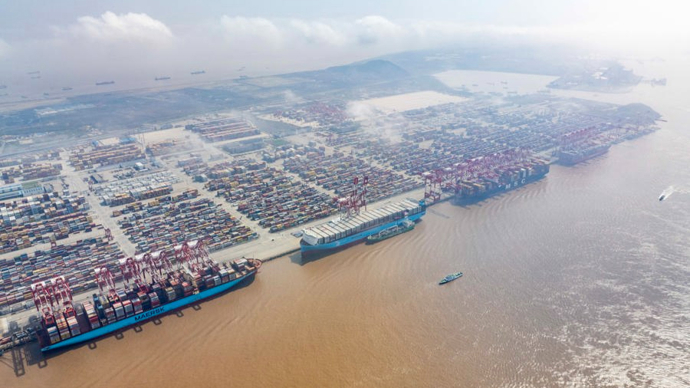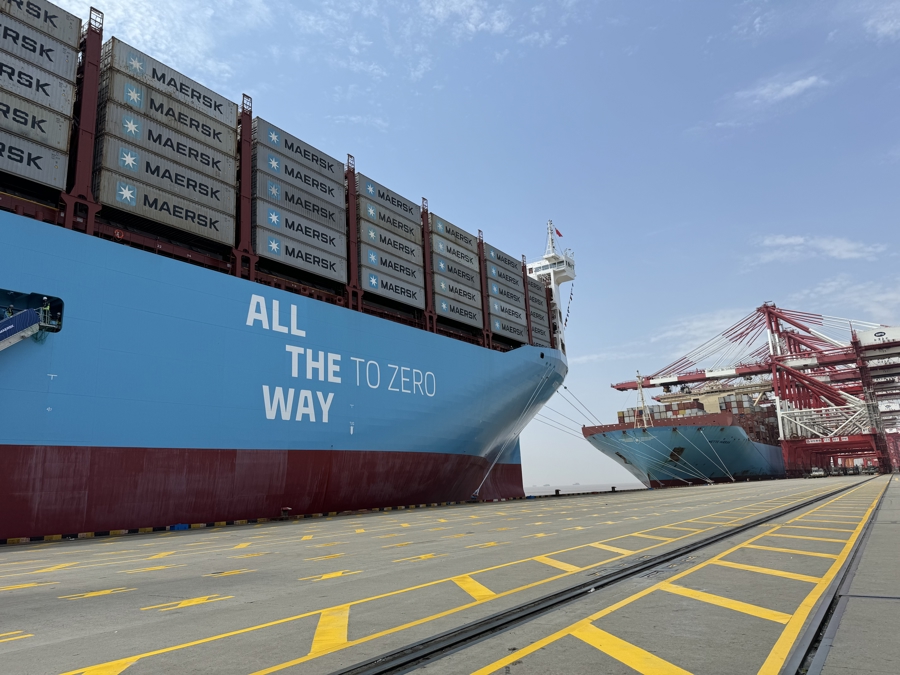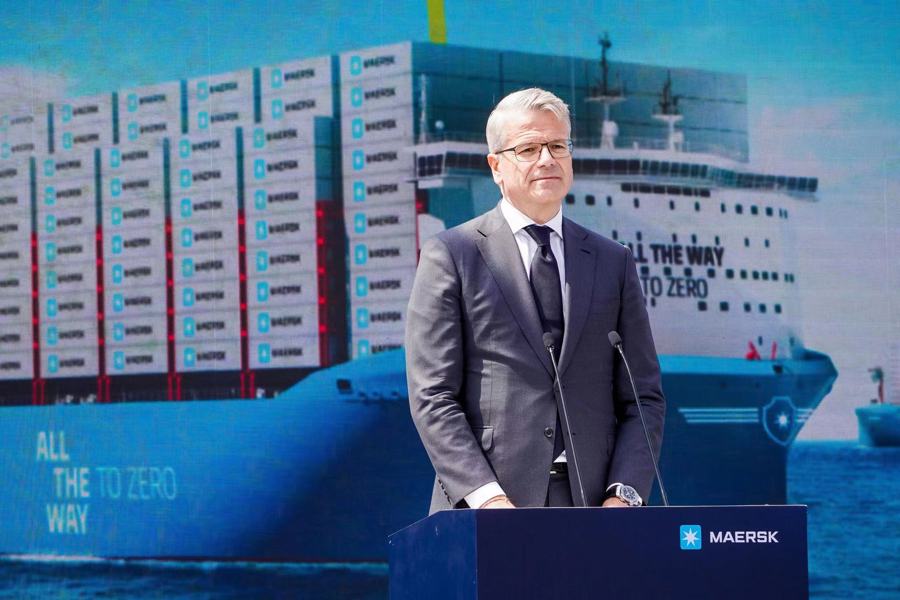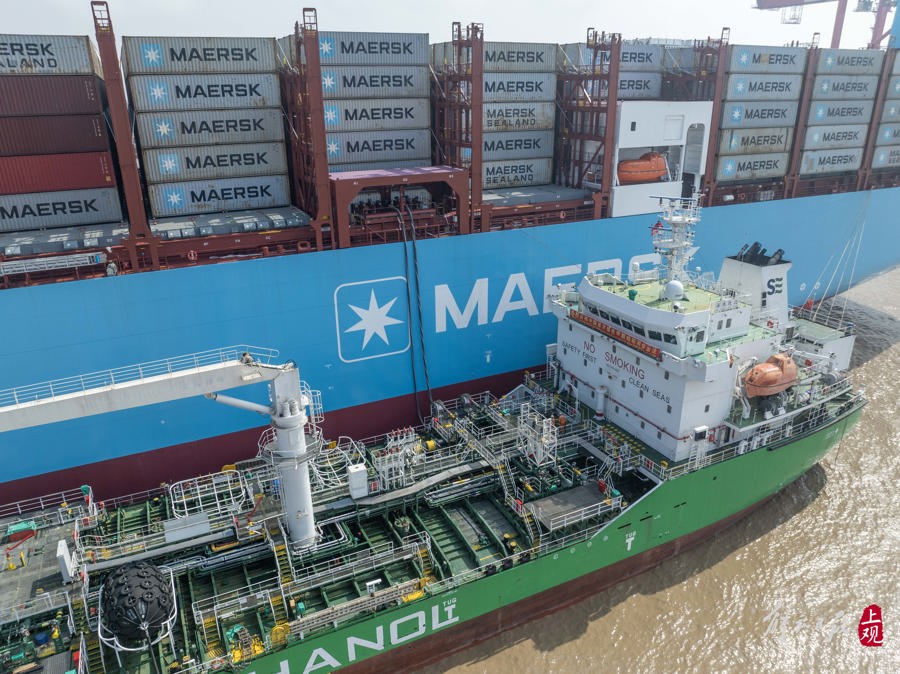The Maersk freighter made a special trip to Shanghai to fill a new type of fuel

On April 10, a container ship of Maersk, a global shipping and logistics company, refueled once at the port of Yangshan in Shanghai. This is one of countless bunkering for more than 730 Maersk vessels. But it's an unusual one-
The leaders of Shanghai came, the Danish ambassador to China came, the CEO of Maersk came, and several buses transported hundreds of witnesses from all over the world to the filling site of Yangshan Port;
In front of the freighter, called "Astrid Maersk", the noisy gongs and drums and flying gold-colored pieces of paper set off the atmosphere as if the name of a new ship;
For this refueling, Yangshan Port also conducted a special combat drill two months ago.
A freighter, once bunkered, has attracted the attention of almost the world's shipping community. Not just shipping, but also the energy sector sees new markets, ports see new demand, and cities see new competitiveness.
The secret lies in the fuel that is injected into the Astrid Maersk: green methanol. This is China's first large-scale green methanol-powered ship synchronous bunkering.

Maersk's large methanol-powered container ship completed China's first green methanol "ship-ship" synchronous bunkering at Shanghai Port.
Clean transformation of the shipping industry
Green methanol, to be mysterious, is that just a few years ago, it was a virtually non-existent product, and even today, people who know about it are limited to the industry.
In fact, it is extremely ordinary, and its molecular formula is no different from ordinary methanol commonly used in the chemical industry. Green methanol is not even green, but a clear liquid like regular methanol.
The "green" of green methanol lies in low-carbon environmental protection, and the attention of green methanol also lies in low-carbon environmental protection. "Green methanol is divided into two types: electric green methanol and biomass green methanol. Li Jun, an associate professor at the Center for Transformative Molecular Frontiers at Shanghai Jiao Tong University and a member of the "Double Carbon" Committee of the Shanghai Chemical Chemistry Society, said: "The former is generated by the reaction of green electricity and carbon dioxide, and the latter is converted from biomass (such as straw). The CO2 emissions of the two green methanol synthesis processes are reduced by at least 70% and 65% respectively compared to conventional processes.
Green methanol is attracting attention from the shipping industry because of its low carbon footprint. Global shipping is responsible for 3% of global greenhouse gas emissions (mainly carbon dioxide). In order to "peak carbon emissions" in international shipping as soon as possible, the International Maritime Organization (IMO) requires net-zero greenhouse gas emissions from ships by 2050. In addition, the EU will implement the Carbon Border Adjustment Mechanism from October 2023 to impose punitive tariffs on excess greenhouse gas emissions.
"Whether it is the International Maritime Organization, the European Union or our government, the requirements for advancing emission reductions are getting higher and higher, and the timetable is getting tighter and tighter. Therefore, the shipping community has now realized that it is no longer possible to wait and see, but must actively move forward. Zhen Hong, director of the Academic Committee of the Shanghai International Shipping Research Center, said.
This means that the shipping industry needs to find new fuels to replace traditional heavy oil. The low-carbon emission green methanol has entered the field of vision of global shipping industry leaders such as Maersk, and the "Astrid Maersk" ship has been refueled at Yangshan Port in Shanghai. The vessel is the second in Maersk's fleet of 18 large methanol-powered container vessels, with the series scheduled to be delivered and operational between 2024 and 2025.
Under Maersk's demonstration, the number of methanol-powered ships has increased rapidly. According to Det Norske Veritas, orders for methanol-fuelled ships reached 138 in 2023, with methanol becoming the most popular alternative fuel of the year for the first time. A total of 29 methanol-capable vessels are currently in operation, while 228 vessels are on order, suggesting a significant increase in methanol-fuelled vessels in the coming years.
Zhang Zhuo, deputy director of the Innovation Center of Shanghai Ship Research and Design Institute of China State Shipbuilding Group and chief expert of ship type, said that 2023 will become a turning point, and at present, shipping companies such as Maersk, CMA CGM, COSCO Shipping, and China Merchants Shipping have methanol dual-fuel ships under construction.

"Astrid Maersk" berthed at Guandong Wharf of Yangshan Deepwater Port.
The Port of Shanghai should take the lead
In fact, behind this grand green methanol filling ceremony, there are many unknown behind-the-scenes scenes. First, Shanghai Yangshan Port is not on the route of the "Astrid Maersk", and the "Astrid Maersk" made a special trip; second, the green methanol refueled does not come from Shanghai, or even from China, but is specially transported to Yangshan Port from overseas.
There is one thing in front of and behind the scenes: Maersk deliberately chose Shanghai to fill green methanol, or in other words, Shanghai deliberately wanted to show the ability of green methanol filling through Maersk. At present, only a few ports in the world, including Shanghai, such as the Port of Rotterdam, have the capacity to refuel marine green methanol. In China, Shanghai was the first to try it.
On April 10, in Yangshan Port, Jens Eskekund, chief representative of Maersk North Asia, was interviewed by Jiefang Daily and Shangguan News, recalling that 18 months ago, it was here that Maersk and SIPG Group discussed green methanol refueling for the first time. Now, 18 months later, behind him, a bunkering vessel is filling the ship "Astrid Maersk" with green methanol.
Shanghai wants to grab this first place, and the reason is very simple: when container ships gradually turn to green methanol as the power, where there is refueling capacity, there will be a more popular port in the future. "At present, Rotterdam and Singapore are recognized as bunkering centers. In the future, a large amount of green energy will be produced in China, and it is natural for Shanghai to develop a huge filling market, comparable to Rotterdam and Singapore. ”
Luo Wenbin, executive director and general manager of SIPG Energy Company, said: "Globally, green methanol refueling is still in the demonstration stage. Therefore, Shanghai must make efforts on green methanol. We are currently in the first echelon, and we can take the lead in building the whole industry chain, so that we can overtake in the energy industry. ”
Shanghai has a greater ambition to seize this first place - to serve the construction of Shanghai's "five centers" such as the international shipping center. Because the refueling service will inevitably bring the demand for energy storage, so that Shanghai will become an energy distribution center and trading place, and the distribution and trading will bring financial demand.
"Realizing the capacity of green methanol fuel bunkering service is a key part of Shanghai Port's construction of a variety of new energy ship bunkering service business system, which can promote the construction of Shanghai Port's clean energy bunkering center faster and better promote the leapfrog development of Shanghai's high-end shipping service industry. Huang Zhifeng, deputy general manager of the Shanghai Energy Conservation and Emission Reduction Center under the Shanghai Consulting Group, said.

Maersk CEO Ke Wensheng delivered a speech at the raising ceremony.
The imagination of green methanol
Maersk has said that after the company's 18 large methanol dual-fuel container ships are delivered in 2025, Maersk needs 750,000 tons of green methanol per year. In 2030, the company expects to need 5 million tons of green methanol, compared to about 20 million tons in 2040.
A research report on the basic chemical industry of Orient Securities has made an analysis, assuming that the proportion of Maersk's capacity in the shipping industry remains unchanged, and the overall penetration progress of green methanol fuel in the shipping industry in 2030 and 2040 is synchronized with Maersk, it can be calculated that the global shipping industry's green methanol demand in 2030 and 2040 will be about 0.34 million and 137 million tons respectively.
However, many analysts believe that this forecast is too optimistic. After all, green methanol is not the only choice, but the current technology is relatively mature, once green ammonia and other technologies are mature, shipping companies may have more choices.
Does this mean that green methanol has a limiting future? Of course not.
Li Jun believes that green methanol can be seen as a way to store green hydrogen. There are also many aspects of hydrogen energy, such as the development of hydrogen fuel cell vehicles in the Korean automotive industry. The biggest problem with hydrogen is that it is difficult to store and transport, and if you convert green hydrogen into green methanol, this problem will be solved.
Huang Zhifeng also pointed out that green methanol should not only be regarded as a new fuel, but also has a lot of room for imagination to replace traditional methanol. "Methanol is an important basic chemical, and chemical derivatives based on methanol are widely used in various industries. He said that reducing carbon emissions is a global consensus, and if the cost transmission mechanism is opened, so that end consumers recognize the concept of green consumption and pay for green products, the application prospects of green methanol will become wider.
At present, the biggest problem facing the development of green methanol is that the production capacity is seriously insufficient, and there are very few projects in the world that have passed green certification and large-scale mass production.
The European Union was the first to formulate a set of green methanol certification standards, which not only strictly restricts the source of raw materials and technical paths for green methanol production, but also has clear restrictions on the whole process of transportation and use. If there is a problem in any link, or the overall carbon emission exceeds the standard, the product cannot be certified and cannot be used as green methanol.
Among the raw materials for green methanol production, biomass is mainly renewable resources such as straw, livestock manure, and garden waste, while green hydrogen mainly comes from green electricity such as wind power and solar energy. The production of these raw materials is limited and needs to be developed more intensively, or a lot of effort to be collected. This also means that the cost of production will not be low.
"Green methanol is currently twice as expensive as conventional methanol. We must upgrade technology and take the road of scale in order to reduce costs and expand the market. Li Jun said.
The good news is that more and more domestic and foreign companies have begun to lay out green methanol projects. In China, a number of investors said that since the second half of 2023, the investment enthusiasm for green methanol has increased significantly.
At present, large energy central enterprises such as China Energy Construction, State Power Investment Corporation, China Chemical, China General Nuclear Power Corporation, and Sinopec, as well as large enterprises in the transportation field such as COSCO Shipping, Geely Holdings, and China Merchants Shipping, as well as private new energy enterprises such as Goldwind Technology, Envision Energy, and Mingyang Group have all entered the market.
In the future, capacity may not be an issue.

Shanghai lays out the whole green methanol industry chain
Shanghai is vying for the first place, and naturally actively lays out the whole green methanol industry chain.
On the storage and transportation side, Yangshan Port has renovated two 10,000 cubic meter methanol storage tanks and a green methanol bunkering vessel with a capacity of 16,000 cubic meters.
"It's more than enough to meet the current stage, but we will further transform and upgrade to prepare for the future in advance. Luo Wenbin said.
In terms of production, on March 30 this year, the first large-scale commercial operation of the wind power coupled biomass green methanol integration demonstration project invested and constructed by Shanghai Electric Group started in Taonan, Jilin Province. The project is planned to be implemented in two phases, with the first phase of building a green methanol production capacity of 50,000 tons/year, and plans to produce the first batch of qualified methanol in 2025 and achieve a production capacity of 250,000 tons by 2027.
"Shanghai Electric is a leading energy equipment company in China, because there is no successful experience of large-scale green methanol plants that have been put into operation in the world, so we choose to promote the industrialization demonstration by ourselves, and in the future, we may also provide one-stop system solutions for more investors engaged in green methanol production at home and abroad. Ni Jianjun, head of the green methanol synthesis plant of Shanghai Electric Taonan Project and executive deputy general manager of Shanghai Electric Luyuan Technology (Jilin) Co., Ltd., said.
As a pioneer, Shanghai Electric has worked with official certification bodies and consulting companies to design production lines, transportation methods, and identify suitable buyers and filling methods to ensure that every step of the process meets the certification requirements for green methanol.
In addition, the reporter learned that Shanghai is also playing a big game of chess. According to people familiar with the matter, Shanghai is studying the formation of a green methanol industry alliance by Shanghai Chengtou, Shenergy Group, Huayi Group and SIPG Group to open up the whole link from biogas purification to methanol synthesis, transportation and terminal filling, so as to realize local production and local supply of green methanol.
In terms of trading and certification training, on April 2 this year, the Management Committee of the Lingang New Area of the Shanghai Free Trade Zone signed a cooperation agreement with the Danish Green Shipping Group, which will build the world's first "methanol marine fuel trading platform" in the Lingang New Area, providing effective tools for upstream and downstream enterprises in the green shipping industry chain to manage forward price risks and promote the physical trading of green methanol, and will set up the first green methanol training and certification center in Lingang.
According to the relevant person in charge of the Shipping Department of the Management Committee of the Lingang New Area, the marine methanol fuel trading platform and green methanol training and certification will help the Lingang New Area to better allocate green fuel resources in the international and domestic markets and build a world-leading green shipping service ecology.
In terms of system exploration, the Shanghai Maritime Safety Administration issued the "Measures for the Safety Management of Methanol Bunkering Operations on Water", which clarified the requirements for the technical specifications of methanol bunkering and the qualifications of management objects, and formed the "Shanghai Standard" for the management system of methanol bunkering operations on marine water in China.
Today, Shanghai has green methanol refueling capacity. It is foreseeable that in the near future, Shanghai will realize the self-supply of green methanol and seize the new business opportunities of the energy revolution in the shipping industry. "When the flowers bloom, the bees will naturally come. Ni Jianjun made an analogy.







